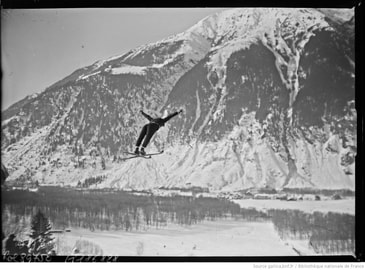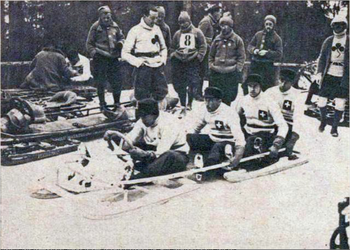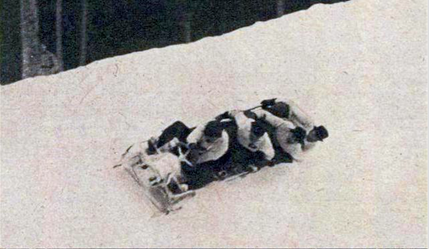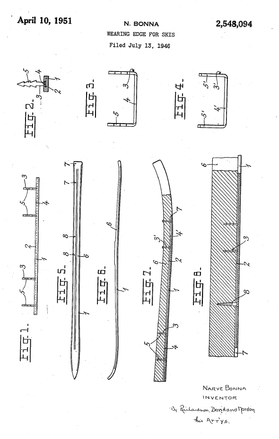An Olympian Inventor
The Story of Narve Bonna and the First Winter Olympics
February 2018
 Narve Bonna (center)
Narve Bonna (center)
With the XXIII Olympic Winter Games taking place this month in PyeongChang, it seems appropriate to revisit the first Winter Olympics and take a look at one its medalists, Narve Bonna, who, in addition to being a world class athlete, was a noted innovator, entrepreneur and patent holder. Read on to learn more; it's a Patently Interesting story!
On January 25, 1924, the first Winter Olympics opened at Chamonix on Mont Blanc in the French Alps. The competition at Chamonix was originally sponsored by the International Olympic Committee (IOC) as an "International Winter Sports Week" and not as an official Olympic Games. The success of the meet prompted the IOC to amend its charter in 1925 to establish the Winter Games. Subsequently, the meet at Chamonix was recognized as the first Winter Olympics.
Notable absences from the first Winter Olympic were Germany and Russia (then part of the Soviet Union). The Soviet Union declined to attend on ideological grounds, while Germany was banned from the competition because of World War I. However, 16 other countries sent athletes to the games to participate in 16 events within 5 different sports, namely bobsleigh, curling, ice hockey, skating and Nordic skiing. Norway and Finland dominated the first Winter Olympics, winning more medals than the other 14 participating countries combined.
Some of the highlights of the first Winter Olympics included the first appearance of Sonja Henie on the world stage. Henie skated in the ladies' figure skating competition, even though she was only eleven years old. While finishing last, she became a crowd favorite and would go on to win gold medals in the next three Winter Olympics. In addition to Henie's debut, the United States won its first gold medal in the Winter Olympics, with Charles Jewtraw’s victory in the 500-meter speed-skating event. Also, Canada won its second Olympic gold medal in hockey, scoring 110 goals and allowing just three goals in five games. The astute reader will question how Canada could win its second Olympic gold medal in hockey at the first Winter Olympics. Well, ice hockey had previously been part of the 1920 Summer Olympic games in Antwerp, Belgium.
Since the first Winter Olympics occurred almost one hundred years ago, they were rather primitive by today's standards, both socially and technologically. Women were allowed to participate in only one event, which was figure skating. The clothing worn by the athletes was not composed of synthetic fibers, such as Lycra, and the equipment was not highly engineered or constructed from composite materials, such as fiberglass. The clothing was made of wool, the skis were wooden and the bobsleds were rather crudely constructed affairs (see below).
On January 25, 1924, the first Winter Olympics opened at Chamonix on Mont Blanc in the French Alps. The competition at Chamonix was originally sponsored by the International Olympic Committee (IOC) as an "International Winter Sports Week" and not as an official Olympic Games. The success of the meet prompted the IOC to amend its charter in 1925 to establish the Winter Games. Subsequently, the meet at Chamonix was recognized as the first Winter Olympics.
Notable absences from the first Winter Olympic were Germany and Russia (then part of the Soviet Union). The Soviet Union declined to attend on ideological grounds, while Germany was banned from the competition because of World War I. However, 16 other countries sent athletes to the games to participate in 16 events within 5 different sports, namely bobsleigh, curling, ice hockey, skating and Nordic skiing. Norway and Finland dominated the first Winter Olympics, winning more medals than the other 14 participating countries combined.
Some of the highlights of the first Winter Olympics included the first appearance of Sonja Henie on the world stage. Henie skated in the ladies' figure skating competition, even though she was only eleven years old. While finishing last, she became a crowd favorite and would go on to win gold medals in the next three Winter Olympics. In addition to Henie's debut, the United States won its first gold medal in the Winter Olympics, with Charles Jewtraw’s victory in the 500-meter speed-skating event. Also, Canada won its second Olympic gold medal in hockey, scoring 110 goals and allowing just three goals in five games. The astute reader will question how Canada could win its second Olympic gold medal in hockey at the first Winter Olympics. Well, ice hockey had previously been part of the 1920 Summer Olympic games in Antwerp, Belgium.
Since the first Winter Olympics occurred almost one hundred years ago, they were rather primitive by today's standards, both socially and technologically. Women were allowed to participate in only one event, which was figure skating. The clothing worn by the athletes was not composed of synthetic fibers, such as Lycra, and the equipment was not highly engineered or constructed from composite materials, such as fiberglass. The clothing was made of wool, the skis were wooden and the bobsleds were rather crudely constructed affairs (see below).
 Bonna using the aerodynamic technique
Bonna using the aerodynamic technique
While the clothing and equipment were rather primitive at the first Winter Olympics, there was one area where technical advancement was on display and it was in the ski jumping event. Two of the participating athletes were Jacob Tullin Thams and Narve Bonna, who were on the Norwegian team. In the early 1920's Thams and Bonna had developed a new style of ski jumping called the "aerodynamic" style or technique. At the time, the conventional technique was for a ski jumper, in flight, to stand upright, with their body and legs disposed at a right angle to their skis. In addition, the ski jumper would typically "windmill" their arms. The "aerodynamic" technique was markedly different from this conventional technique and greatly increased the distance that could be jumped. In the aerodynamic technique, the body and legs of the ski jumper were strongly angled forward, out over the skis, with the arms and shoulders kept still, typically in a forwardly-extended position. The aerodynamic style was later perfected by Sigmund Rudd and became known as the Kongsberger technique. Unfortunately, only Thams and Rudd are credited with developing the Kongsberger technique, with Bonna's contribution being largely forgotten.
Thams and Bonna both used the aerodynamic technique to respectively win the gold and silver medals in ski jumping at the first Winter Olympics. The bronze medal was awarded to fellow Norwegian, Thorleif Haug, and fourth place went to Norwegian-American, Anders Haugen. Fifty years later, however, it was discovered that a mathematical error had been made in the scoring and Anders Haugen was rightfully the bronze medalist. To this day, Haugen is the only American to win an Olympic medal in ski jumping.
After the Olympics, Bonna went to work building skis. He worked three years at the Splitkein Ski Factory, which was established by Peter Østby. There, Bonna learned how to build the famous Splitkein ski, which was a type of ski made from a plurality of layers of laminated wood. In 1939, Bonna left the Splitkein Ski Factory and, together with Captain Earl Willoch, started their own ski factory in Bonna's hometown of Lommedalen, Norway. The factory was aptly named the Lommedalen Ski Factory. At about the same time, Bonna filed a Norwegian patent application for a laminated ski that was an improvement on the Splitkein ski. Corresponding patent applications were filed in Canada and France and issued as patents CA396444 and FR863459, respectively. Later, Bonna filed a Norwegian patent application for a metal wearing edge for skis. A corresponding U.S. patent application issued as U.S. Patent No.: 2,548,094.
In 1959, Bonna's Lommedalen Ski Factory produced the first fiberglass touring skis. Unfortunately, the ski touring world was not ready for them. It took Bonna over five years to sell his first pair. At the time, touring skiers wanted wood, not plastic. So, Bonna gave them what they wanted. He came out with a new brand of wooden touring skis, the eponymous BONNA line of skis, which became very popular because of their high-quality construction.
When the attitude against fiberglass touring skis abruptly changed in the mid-1970s, the Lommedalen Ski Factory again began to sell fiberglass touring skis, this time under the BONNA brand. Bonna had never given up on his belief that fiberglass was the future for ski manufacturing, as is evidenced by his filing of a Norwegian patent application in 1966 for a method of forming a fiberglass ski with a wooden core. Fortunately, Bonna lived long enough to see his vision fulfilled. He passed away in 1976 in Lommedalen, a quiet corner of Norway from which Bonna helped change the world of skiing.
Thams and Bonna both used the aerodynamic technique to respectively win the gold and silver medals in ski jumping at the first Winter Olympics. The bronze medal was awarded to fellow Norwegian, Thorleif Haug, and fourth place went to Norwegian-American, Anders Haugen. Fifty years later, however, it was discovered that a mathematical error had been made in the scoring and Anders Haugen was rightfully the bronze medalist. To this day, Haugen is the only American to win an Olympic medal in ski jumping.
After the Olympics, Bonna went to work building skis. He worked three years at the Splitkein Ski Factory, which was established by Peter Østby. There, Bonna learned how to build the famous Splitkein ski, which was a type of ski made from a plurality of layers of laminated wood. In 1939, Bonna left the Splitkein Ski Factory and, together with Captain Earl Willoch, started their own ski factory in Bonna's hometown of Lommedalen, Norway. The factory was aptly named the Lommedalen Ski Factory. At about the same time, Bonna filed a Norwegian patent application for a laminated ski that was an improvement on the Splitkein ski. Corresponding patent applications were filed in Canada and France and issued as patents CA396444 and FR863459, respectively. Later, Bonna filed a Norwegian patent application for a metal wearing edge for skis. A corresponding U.S. patent application issued as U.S. Patent No.: 2,548,094.
In 1959, Bonna's Lommedalen Ski Factory produced the first fiberglass touring skis. Unfortunately, the ski touring world was not ready for them. It took Bonna over five years to sell his first pair. At the time, touring skiers wanted wood, not plastic. So, Bonna gave them what they wanted. He came out with a new brand of wooden touring skis, the eponymous BONNA line of skis, which became very popular because of their high-quality construction.
When the attitude against fiberglass touring skis abruptly changed in the mid-1970s, the Lommedalen Ski Factory again began to sell fiberglass touring skis, this time under the BONNA brand. Bonna had never given up on his belief that fiberglass was the future for ski manufacturing, as is evidenced by his filing of a Norwegian patent application in 1966 for a method of forming a fiberglass ski with a wooden core. Fortunately, Bonna lived long enough to see his vision fulfilled. He passed away in 1976 in Lommedalen, a quiet corner of Norway from which Bonna helped change the world of skiing.
Proudly powered by Weebly





